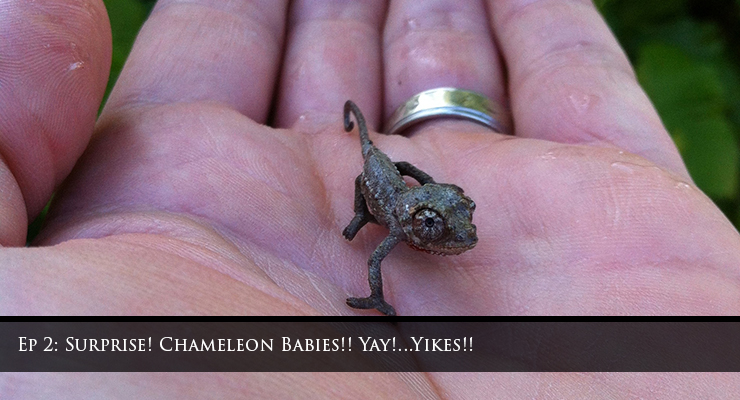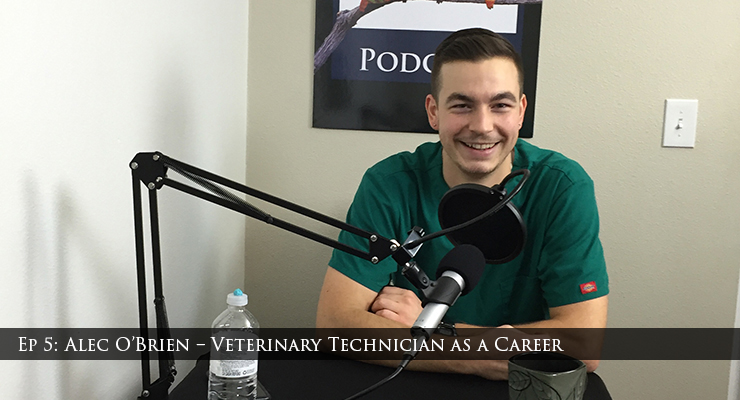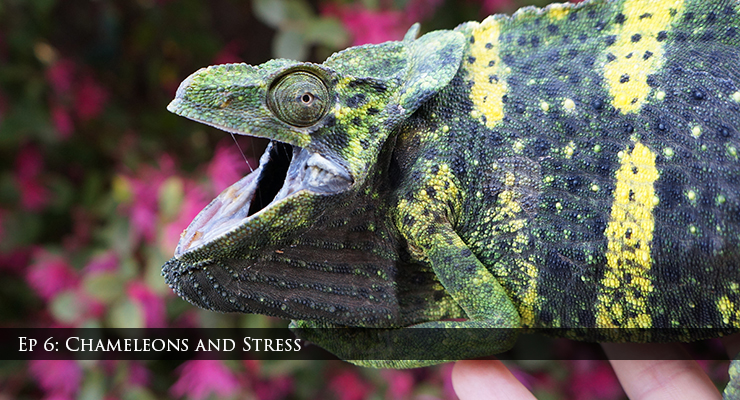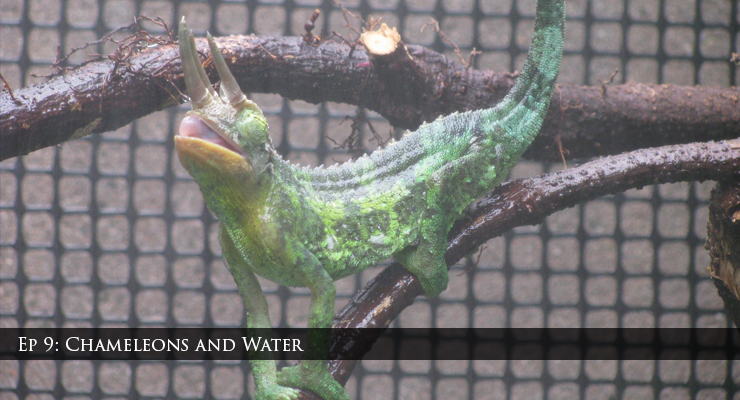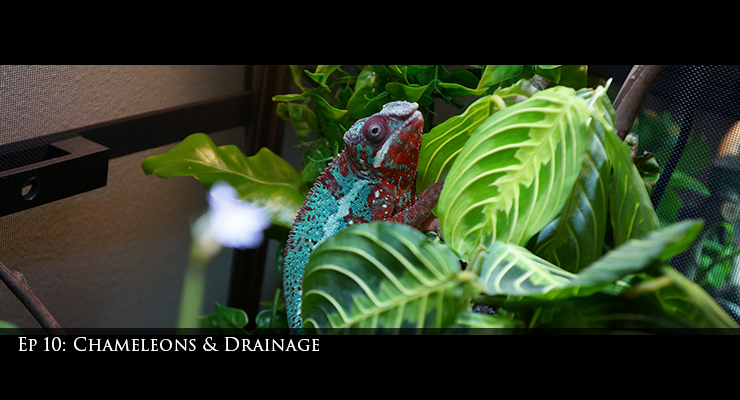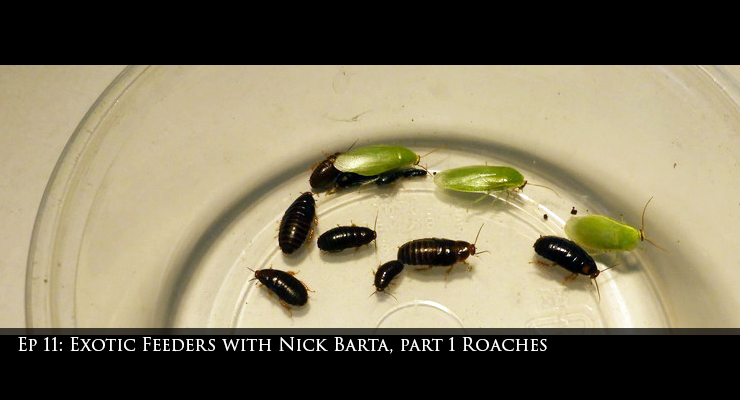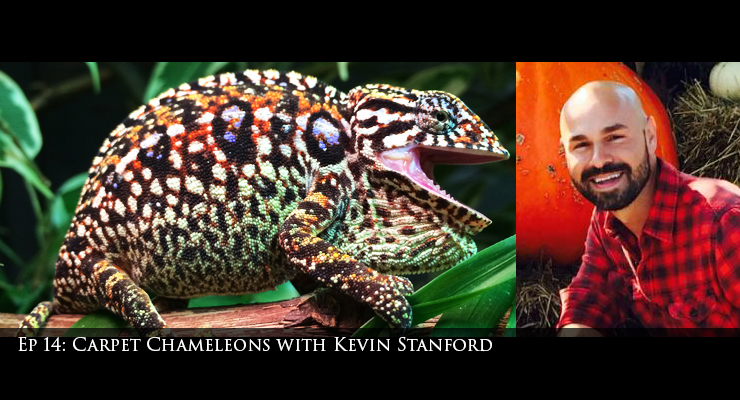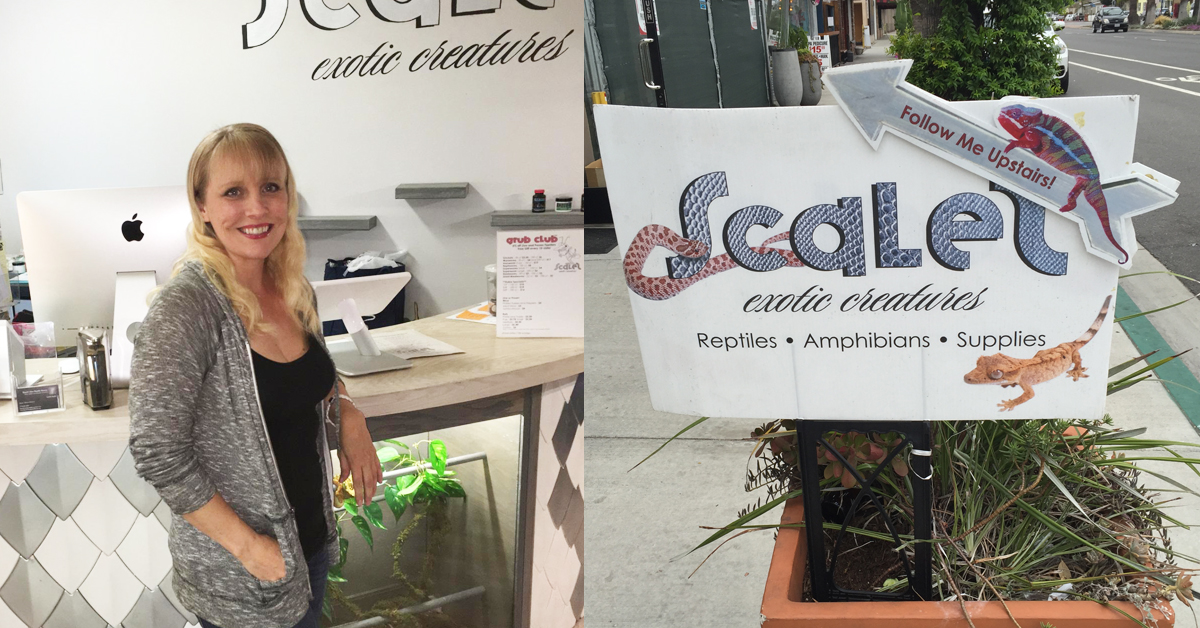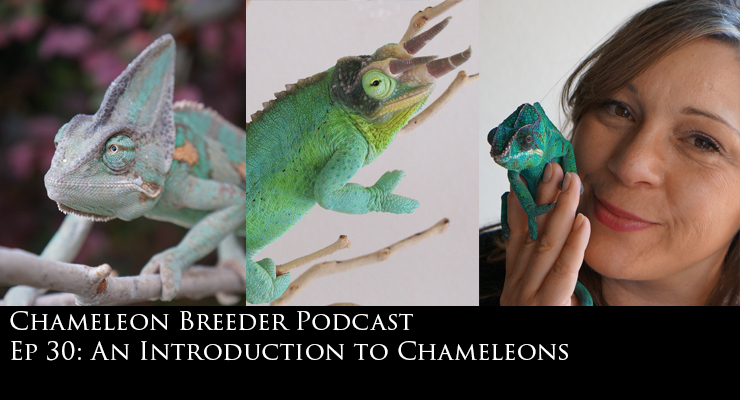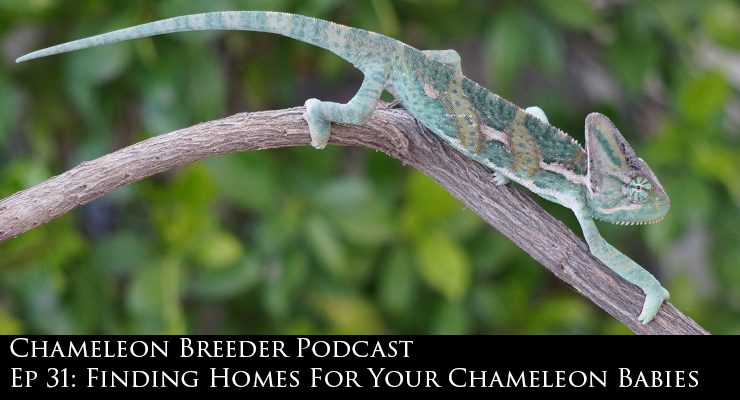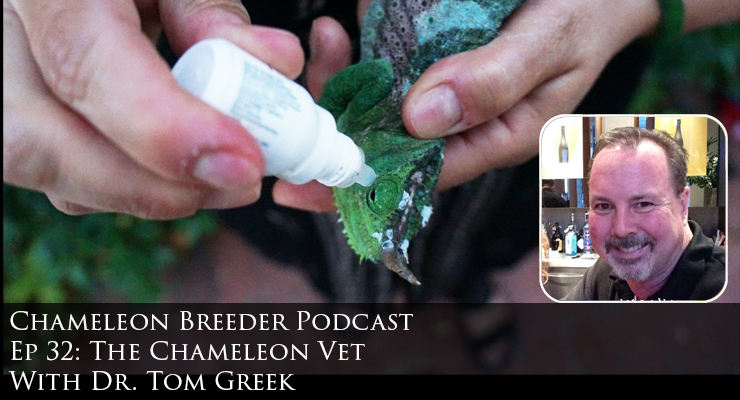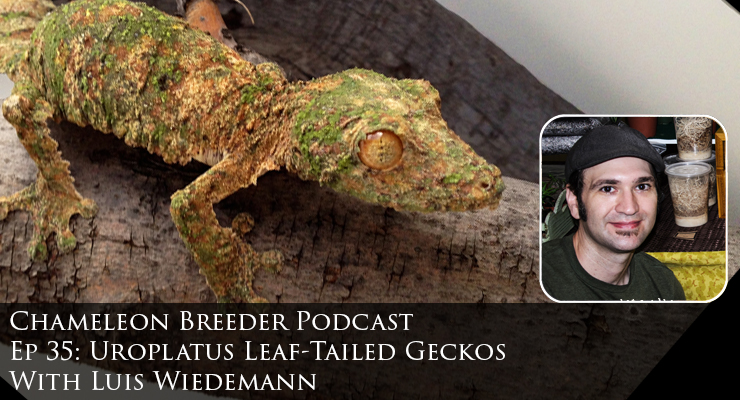How do we make for a content chameleon? The answer is to create not only microclimates, but also gradients between those microclimates. We want to give our chameleons the most choices in temperature, humidity, UVB, and privacy as possible. By allowing our chameleon to choose where they are most comfortable we are putting chameleon care, at least partially, in the hands of the undisputed expert – your chameleon. All we have to do is give him the tools to work with. This episode of the Chameleon Breeder Podcast discusses just that.
Click image for show notes – activate the audio player to hear the episode
Bill Strand
Micro-climates & Gradients
Today’s episode 002 is titled Surprise! Chameleon Babies!! Yay!…Yikes!! In honor of all the emotions we go through when baby chameleons hatch or are born. But, you ask, what is the Yikes in there for? Aren’t breeders all prepared for hatch date? Perhaps, but then there are the ones that are surprised by eggs hatching two months before estimated hatch date and then there are the livebearers that can give birth at any inconvenient time – such as 9 months after you have brought back a single female Jackson’s chameleon from the show with no intention of ever breeding her! You walk down the stairs one morning and instead of a nice cup of coffee waiting for you, you find a cage full of baby chameleons staring at you and one tired momma. Whoa! Talk about needing to find an accelerated crash course in baby chameleon care! I can’t say we will cover everything here, but we will touch on the important parts and make sure you are off to a good start!
Click image for show notes – activate the audio player to hear the episode
Bill Strand
Surprise Chameleon Babies! Yay!....Yikes!
Vacations and holidays are wonderful things and we all need the down time to sample exotic cuisines, but for chameleon people there is always a stress that comes along with the excitement…how do I take care of my chameleon? Chameleons are wonderful, but they do take daily maintenance and, as hardy as they are, we do not like it when our friends go without. So, in honor of the coming holidays, we are, today, going to talk about leaving your chameleon for four days to two weeks and how to pull that off. If you do it right, the worst that will happen is that you’ll feel a low grade stress and your chameleon is still sitting on his same branch, a couple grams heavier, looking at you when you walk back in the door.
Click image for show notes – activate the audio player to hear the episode
Bill Strand
Vacations & Chameleons at Home
From the podcast:
“Welcome to Episode 004. I have a special treat for you. Briana Kammer, of Kammerflage Kreations is here in the studio. For those that don’t know her, Briana is the customer and social media interface for the most successful and long running chameleon breeding operation, Kammerflage Kreations. If you call Kammerflage chances are you will speak with Briana. Of all the people in the chameleon world, she is likely the one that has the most experience helping first time chameleon keepers get started.
Today we are going to talk about what it is like being a beginner and the challenges and questions first time chameleon keepers have these days.”
Click image for show notes – activate the audio player to hear the episode
Bill Strand
Briana Kammer Interview
Explore what a career as a Veterinary Technician is like! We speak with Alec O’Brien who works as a vet tech and gives us an inside view of his job and life. Have you considered a career with animals? Listen in and decide whether a Vet Tech is a direction for you!
Click image for show notes – activate the audio player to hear the episode
Bill Strand
Alec O'Brien Veterinary Technician
Explore the relationship between chameleons and stress. We go over the three stress zones: Comfort, tolerance, and intolerance and then delve into different kinds of stress including stress spikes, internal physical stress, external physical stress, and emotional stress. Most importantly, we go over the communication that chameleons give you to show that something is not right. We often miss these because we don’t speak chameleon! Well, this is your first lesson in chameleon speak! By learning the signs of stress you are well versed to eliminate it as much as is possible from your chameleon’s life!
Click image for show notes – activate the audio player to hear the episode
Bill Strand
Chameleons and Stress
Carpet chameleons are a small species from Madagascar that are named for the intricately beautiful patterns they show. This species has the characteristic of being one of the few where the female is more colorful than the male. Breeding these jewels was, at one time, problematic and there were only brief pockets of success in the community. Kevin Stanford has spearheaded the effort for breeding success and is now working with 6th Captive Generation specimens.
While forward movement is always built on the backs of those who have gone before us and is fanned by those who work with us, there is often one person whose efforts become a catalyst for the community. In carpet chameleons, that has been Kevin Stanford. In this episode we talk with Kevin about his methods for successfully breeding carpet chameleons and his journey to get to this point.
Click image for show notes – activate the audio player to hear the episode
Bill Strand
Carpet Chameleons with Kevin Stanford
Stick insects are one of the most fascinating of the insects chameleon keepers use as feeders. Whether you use them as feeders or, like the rest of us, find that we’d rather keep them as pets, you’ll find out here how to take care of them. From the bizarre Australian Stick Insect to the huge Green Bean Insect to the cryptic leaf insect, you’ll find no end to the wonder of stick insects!
Click image for show notes – activate the audio player to hear the episode
Bill Strand
Ep 15: Stick Insects with Nick Barta
Exposing your chameleon to natural sunlight brings great health benefits. In this episode we explore how you can accomplish this in your husbandry as simply as moving your indoor cage out to the patio for a couple hours or as in depth as building a permanent outdoor cage. Building outdoor cages is great fun and few things are as impressive as a healthy chameleon in a well planted outdoor cage!
Click image for show notes – activate the audio player to hear the episode
Bill Strand
Ep 16: Outdoor Chameleon Keeping

From the dinosaur-like horns to the live birth to the gentle personality, the Jackson’s Chameleon is one of the most fascinating of the chameleon species. In this episode we discuss bringing one of these wonderful creatures into your home.
Activate the audio player to hear the episode
Bill Strand
Ep 17: Bringing a Jackson's Chameleon Home

Wild caught chameleons come with their own special challenges. Listen in as we go over deciding whether a wild caught vs. captive bred is best for you. If you need a new chameleon for a breeding group then we go over the selection process and acclimation steps.
Activate the audio player to hear the episode
Bill Strand
Ep 18: Wild Caught Chameleons & Acclimation
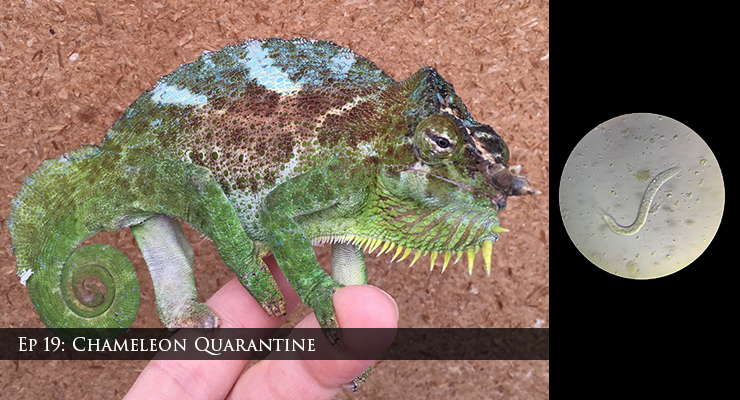
Listen in as Alec O’Brien leads us through basics of the quarantine procedure for chameleons. When bringing a new chameleon home it is important that you put them through a quarantine whether wild caught or captive bred. This allows you to test for parasites and watch for disease to ensure you do not introduce pathogens to your collection.
Activate the audio player to hear the episode
Bill Strand
Ep 19: Chameleon Quarantine

Dr. Chris Anderson discusses life as a chameleon research scientist and hobbyist. We talk about chameleon conservation and how the chameleon community can be part of conservation projects.
Activate the audio player to hear the episode
Bill Strand
Ep 20: Dr. Chris Anderson and Chameleon Conservation

One of the most exciting events in the chameleon world is the recent availability of South African Dwarf Chameleons, such as Bradypodion thamnobates, to hobbyists. These finger sized,colorful live bearers are hardy and full of character. Join us as Bradypodion breeder, Seth Bredenkamp, introduces us to this wonderful group of chameleons
Activate the audio player to hear the episode
Bill Strand
Ep 21: South African Dwarf Chameleons

Four different breeders give their insight into the care of Trioceros quadricornis, the Four-horned Chameleon. They may no longer be imported, but there are enough clutches incubating that a new generation of quad breeders will have enough to keep this species going in captivity, at least for the near future.
Activate the audio player to hear the episode
Bill Strand
Ep 22: T. quadricornis, the Four-horned Chameleon
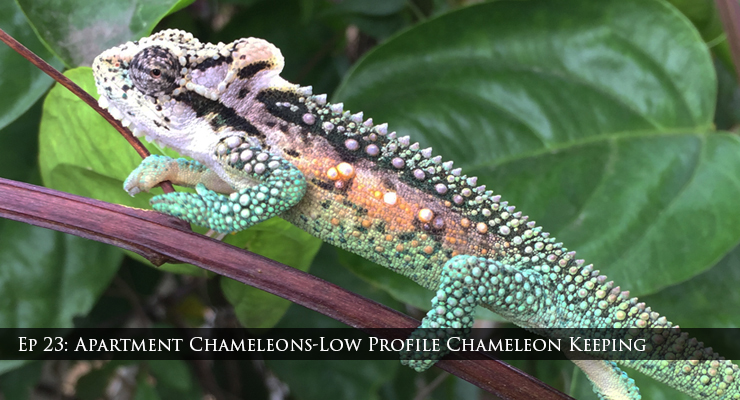
This week, I’d like to talk about keeping chameleons in small spaces such as an apartment or a bedroom. Many of us fall in love with chameleons before we are out of our parent’s house or are living in apartments, condominiums, or Townhomes where other people are quite close. You have the passion, but having to coordinate that passion with overlapping living spaces is not always easy.
Activate the audio player to hear the episode
Bill Strand
Ep 23: Apartment Chameleons-Low Profile Chameleon Keeping
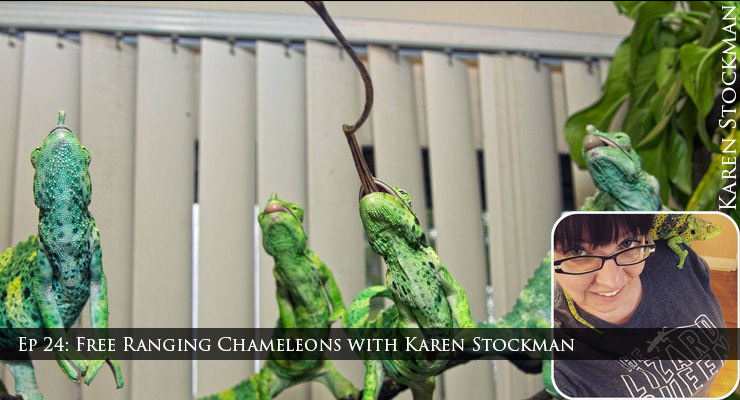
Most everyone who keeps a chameleon has considered some sort of a free range. We like being with our animals. And it seems obvious that our chameleons would like it better to be free to go where they please. So today we are going to talk about free ranging your chameleons. What is it like and how do you do it?
Activate the audio player to hear the episode
Bill Strand
Ep 24: Free Ranging Chameleons

Trioceros deremensis is an amazingly beautiful creature. With sail fins and triceratops horns, T. deremensis has great character! Listen as Luis Wiedemann, speaks about his long term project of reproducing deremensis.
Activate the audio player to hear the episode
Bill Strand
Ep 25: Trioceros deremensis with Luis Wiedemann

Shipping chameleons has always intimidated chameleon keepers. Where does the box go and what happens between here and there? How do I even do it and keep my chameleon safe? This week I am joined by Chad Brown of ShipYourReptiles.com and he answers all my questions about proper shipping of reptiles!
Activate the audio player to hear the episode
Bill Strand
Ep 26: Shipping Chameleons with Chad Brown
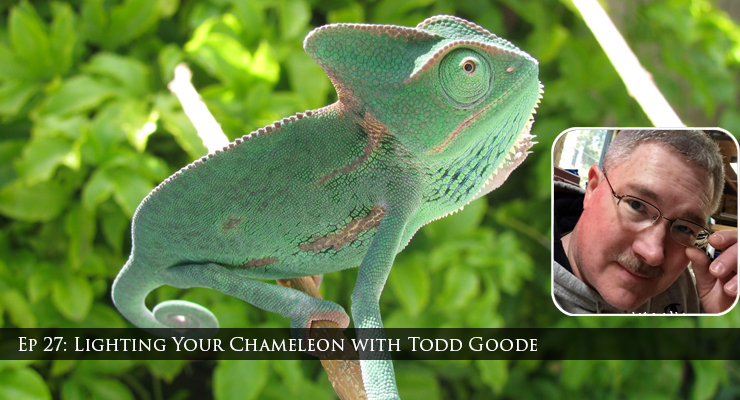
Today we talk with Todd Goode from LightYourReptiles.com about the critical issue of lighting for chameleons. Listen in as some technical terms are defined and we discuss proper lighting for good chameleon husbandry.
Activate the audio player to hear the episode
Bill Strand
Ep 27: Lighting Chameleons with Todd Goode
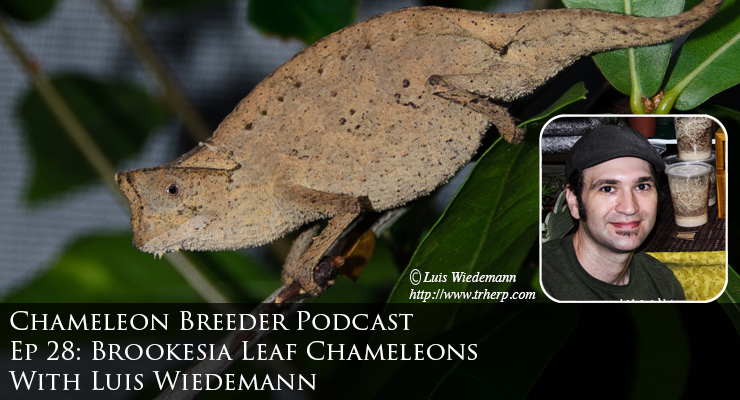
The Brookesia genus of chameleons. They are small, they are cryptic, and they are fascinating! Luis Wiedemann, a Podcast favorite, comes back on and gives us a window into how to take care of these little chameleons!
Activate the audio player to hear the episode
Bill Strand
Ep 28: Brookesia chameleons with Luis Wiedemann
How many of you have ever dreamed of owning a pet store? Yep, my hand is raised right now too! If you are driving, please put your hand back down. For today’s episode I went on location to Scales Exotic Creatures in Long Beach California run by Beth Greathouse. This reptile boutique is a unique take on the standard reptile store. Instead of walls packed with random reptiles and aging boxes of weathered inventory, there are carefully selected species, care products, T-shirts, stuffed animals, and even a specialized supplement line. I got a special interview with Beth before the store opened today. I talked with her about setting up the store and what a day in the life of a pet store owner was like. We then take a short tour around and discuss the reptiles that she offers and the reason for each. When you are creating a pleasant environment, overcrowding is definitely out and so each species is chosen carefully and with purpose.
Activate the audio player to hear the episode
Bill Strand
Ep 29: Owning a Reptile Store
If you are interested in getting a chameleon, this episode is for you! We condense the most important points about chameleon keeping into one hour of listening! Now, understand that this is a high level overview. Each one of the topics reviewed could easily be an entire episode on their own! But this episode gets you started with some answers, but mostly to let you know the right questions to ask.
Activate the audio player to hear the episode
Bill Strand
Ep 30: Introduction to Chameleons
Today we talk about finding, or creating, good homes for the chameleon babies you raise up. A big part of this is setting yourself up so you do not get pressured to make a quick sale. That way you can be selective as to where you sell the baby chameleons you worked so hard to raise up.
Activate the audio player to hear the episode
Bill Strand
Ep 31: Finding Homes for your Baby Chameleons
Dr. Greek is an exotics veterinarian with long time experience with chameleons. Finding this kind of vet is a victory for any chameleon owner! In this episode we talk to him about what he sees with chameleons in his office. We discuss issues such as MBD, eye infections, inaction, and plant poisoning. Dr. Greek gives us some advice on how we can avoid common problems.
Activate the audio player to hear the episode
Bill Strand
Ep 32: The Chameleon Veterinarian with Dr. Tom Greek
Jackson’s Chameleons have established themselves in Hawaii. Today we talk with Mary Lovein who lives among those chameleons. More than just a thrill to see chameleons in the wild, she has been able to observe Jackson’s behavior in their natural state. She comes on the podcast to share what she has noted over the years of watching the chameleons come and go!
Activate the audio player to hear the episode
Take a step back in time as Philippe de Vosjoli, the man behind the Advanced Vivarium Systems books and the Vivarium Magazine, takes us on a tour of the early days of keeping chameleons. The vision and inspiration that the community had 20 to 30 years ago is still relevant for us today!
Activate the audio player to hear the episode
Welcome to the Outer Fringes! This series takes advantage of the husbandry skills that chameleon keepers develop and shows what other reptiles and amphibians can live with the same type of husbandry. Today, on the Outer Fringes, Luis Wiedemann joins us as we dive into Uroplatus Leaf-tailed Geckos of Madagascar!
Activate the audio player to hear the episode

This week we explore a listener question about chameleon husbandry in high humidity environments. And then we learn of an exciting new show being put on by artist Evan Skrederstu – The 8th Continent Show. This show/auction/presentation is a fusion of art and science in the Los Angeles art scene. 30% of the proceeds from the auction goes to Madagascar conservation. Listen in as Evan describes his vision!
Activate the audio player to hear the episode
Today we explore poisonous plants and pesticides. Be aware of the plants going into your caged make the right choices. This episode gives you the foundation to understand how poisonous plants and pesticides affect us as chameleon keepers.
Activate the audio player to hear the episode
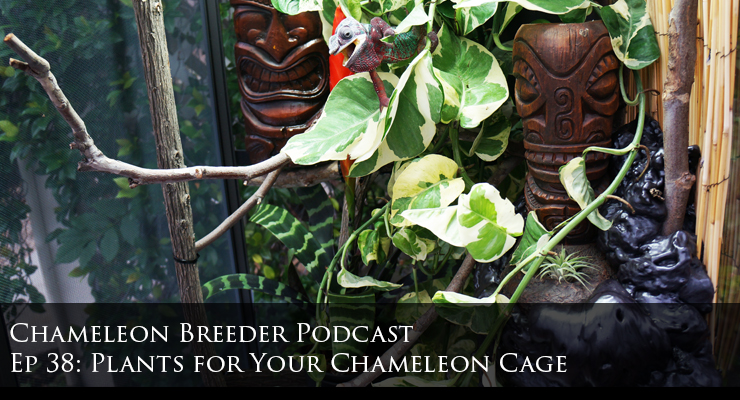
Plants are a functional cornerstone of a chameleon’s cage. They are also a source of great beauty. In this episode I get you started on using live plants in your chameleon’s environment. With just a little bit of knowledge you can turn your chameleon cage into an incredible chameleon environment!
Activate the audio player to hear the episode
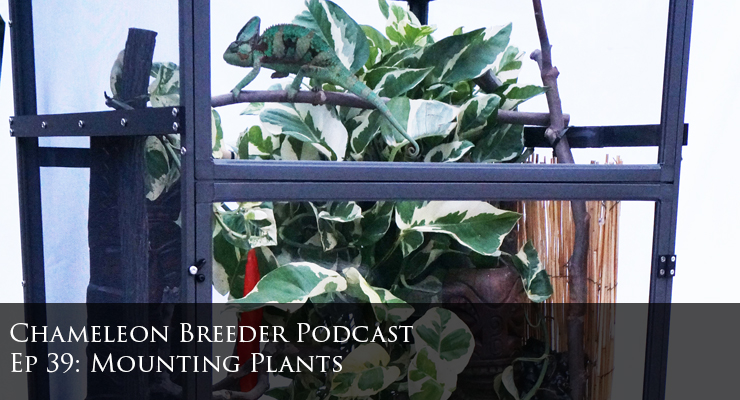
How do I mount plants in my screen chameleon cage? In this episode we review your options. We gets our hands dirty and talk tactics! How do you create a branch support grid? What angle do you mount your plants? How many anchor points are needed? We answer all these questions that you may not know you have until you actually try to put a live plant in the cage!
Activate the audio player to hear the episode


